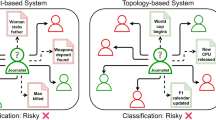Abstract
This study delves into the privacy risks associated with user interactions in complex networks such as those generated on social media platforms. In such networks, potentially sensitive information can be extracted and/or inferred from explicitly user-generated content and its (often uncontrolled) dissemination. Hence, this preliminary work first studies an unsupervised model generating a privacy risk score for a given user, which considers both sensitive information released directly by the user and content propagation in the complex network. In addition, a supervised model is studied, which identifies and incorporates features related to privacy risk. The results of both multi-class and binary privacy risk classification for both models are presented, using the Twitter platform as a scenario, and a publicly accessible purpose-built dataset.
Access this chapter
Tax calculation will be finalised at checkout
Purchases are for personal use only
Similar content being viewed by others
Data Availability
The labeled dataset generated and used in this work is available on request from the corresponding author.
Notes
- 1.
https://www.nytimes.com/2023/08/03/technology/twitter-x-tweets-elon-musk.html, accessed on September 1, 2023.
- 2.
This can happen, for example, when a tweet is retweeted or mentioned by users with a large following, thus amplifying its reach.
- 3.
- 4.
- 5.
- 6.
References
Abrams, M., Weiss, H., Giusti, S., Litner, J.: 47 terms that describe sexual attraction, behavior, and orientation (2023). https://www.healthline.com/health/different-types-of-sexuality. Accessed 1 April 2023
Aghasian, E., Garg, S., Gao, L., Yu, S., Montgomery, J.: Scoring users’ privacy disclosure across multiple online social networks. IEEE Access 5, 13118–13130 (2017)
Akcora, C., Carminati, B., Ferrari, E.: Privacy in social networks: how risky is your social graph?. In: Proceedings of ICDE, vol. 2012, pp. 9–19 (2012)
Caliskan Islam, A., Walsh, J., Greenstadt, R.: Privacy detective: detecting private information and collective privacy behavior in a large social network. In: Proceedings of WPES 2014, pp. 35–46 (2014)
Carminati, B., Ferrari, E., Viviani, M.: Online social networks and security issues. In: Security and Trust in Online Social Networks. Synthesis Lectures on Information Security, Privacy, and Trust, pp. 1–18. Springer, Cham (2014). https://doi.org/10.1007/978-3-031-02339-2_1
Centers for Disease Control and Prevention. List of all diseases (2022). https://www.cdc.gov/health-topics.html. Accessed 2 March 2022
Chawla, N.V., Bowyer, K.W., Hall, L.O., Kegelmeyer, W.P.: SMOTE: synthetic minority over-sampling technique. JAIR 16, 321–357 (2002)
De Capitani di Vimercati, S., Foresti, S., Livraga, G., Samarati, P.: Data privacy: definitions and techniques. IJUFKBS 20(6), 793–817 (2012)
De Capitani di Vimercati, S., Foresti, S., Livraga, G., Samarati, P.: \(k\)-Anonymity: from theory to applications. Trans. Data Priv. 16(1), 25–49 (2023)
Eurostat: Explained. Glossary: marital status (2019). https://ec.europa.eu/eurostat/statistics-explained/index.php?title=Glossary:Marital_status. Accessed 2 Mar 2022
Ferrari, E., Viviani, M.: Privacy in social collaboration. In: Michelucci, P. (ed.) Handbook of Human Computation, pp. 857–878. Springer, New York (2013). https://doi.org/10.1007/978-1-4614-8806-4_70
Foreman, Z., Bekman, T., Augustine, T., Jafarian, H.: PAVSS: privacy assessment vulnerability scoring system. In: Proceedings of CSCI, vol. 2019, pp. 160–165 (2019)
Geonames - All cities with a population \(>\) 1000 (2023). https://public.opendatasoft.com/explore/dataset/geonames-all-cities-with-a-population-1000. Accessed 1 Apr 2023
Hossin, M., Sulaiman, M.N.: A review on evaluation metrics for data classification evaluations. IJDKP 5(2), 1 (2015)
Järvelin, K., Kekäläinen, J.: Cumulated gain-based evaluation of IR techniques. ACM TOIS 20(4), 422–446 (2002)
joblist.com: List of all jobs (2022). https://www.joblist.com/b/all-jobs. Accessed 2 Mar 2022
Kircaburun, K., Alhabash, S., Tosuntaş, Ş, Griffiths, M.D.: Uses and gratifications of problematic social media use among university students: a simultaneous examination of the big five of personality traits, social media platforms, and social media use motives. IJMHA 18, 525–547 (2020)
Kökciyan, N., Yolum, P.: PriGuard: a semantic approach to detect privacy violations in online social networks. IEEE TKDE 28(10), 2724–2737 (2016)
Liu, K., Terzi, E.: A framework for computing the privacy scores of users in online social networks. ACM TKDD 5(1), 1–30 (2010)
Livraga, G., Motta, A., Viviani. M.: Assessing user privacy on social media: the Twitter case study. In: Proceedings of OASIS 2022, Barcelona, Spain, June (2022)
Matthews, P.: Social media, community development and social capital. CDJ 51(3), 419–435 (2016)
McDonald, A.M., Cranor, L.F.: The cost of reading privacy policies. ISJLP 4, 543 (2008)
Pei, S., Muchnik, L., Tang, S., Zheng, Z., Makse, H.A.: Exploring the complex pattern of information spreading in online blog communities. PLoS ONE 10(5), e0126894 (2015)
Shibchurn, J., Yan, X.: Information disclosure on social networking sites: an intrinsic-extrinsic motivation perspective. CHB 44, 103–117 (2015)
Watson, J., Lipford, H.R., Besmer, A.: Mapping user preference to privacy default settings. ACM TOCHI 22(6), 1–20 (2015)
Wikipedia contributors: List of contemporary ethnic groups – Wikipedia, the free encyclopedia (2022). https://en.wikipedia.org/wiki/List_of_contemporary_ethnic_groups. Accessed 2 Mar 2022
Wikipedia contributors: List of generic names of political parties – Wikipedia, the free encyclopedia (2022). https://en.wikipedia.org/wiki/List_of_generic_names_of_political_parties. Accessed 2 Mar 2022
Wikipedia contributors: List of religions and spiritual traditions – Wikipedia, the free encyclopedia (2022). https://en.wikipedia.org/wiki/List_of_religions_and_spiritual_traditions. Accessed 2 Mar 2022
Wong, T.-T., Yeh, P.-Y.: Reliable accuracy estimates from k-fold cross validation. IEEE TKDE 32(8), 1586–1594 (2019)
Yang, J., Rahardja, S., Fränti, P.: Outlier detection: how to threshold outlier scores?. In: Proceedings of AIIPCC, vol. 2019, pp. 1–6 (2019)
Acknowledgements
This work was supported in part by project SERICS (PE00000014) under the NRRP MUR program funded by the EU - NGEU, by project KURAMi (20225WTRFN) under the PRIN 2022 MUR program, and by the EC under grants MARSAL (101017171) and GLACIATION (101070141).
Author information
Authors and Affiliations
Corresponding author
Editor information
Editors and Affiliations
Rights and permissions
Copyright information
© 2024 The Author(s), under exclusive license to Springer Nature Switzerland AG
About this paper
Cite this paper
Livraga, G., Olzojevs, A., Viviani, M. (2024). Unveiling the Privacy Risk: A Trade-Off Between User Behavior and Information Propagation in Social Media. In: Cherifi, H., Rocha, L.M., Cherifi, C., Donduran, M. (eds) Complex Networks & Their Applications XII. COMPLEX NETWORKS 2023. Studies in Computational Intelligence, vol 1144. Springer, Cham. https://doi.org/10.1007/978-3-031-53503-1_23
Download citation
DOI: https://doi.org/10.1007/978-3-031-53503-1_23
Published:
Publisher Name: Springer, Cham
Print ISBN: 978-3-031-53502-4
Online ISBN: 978-3-031-53503-1
eBook Packages: EngineeringEngineering (R0)




